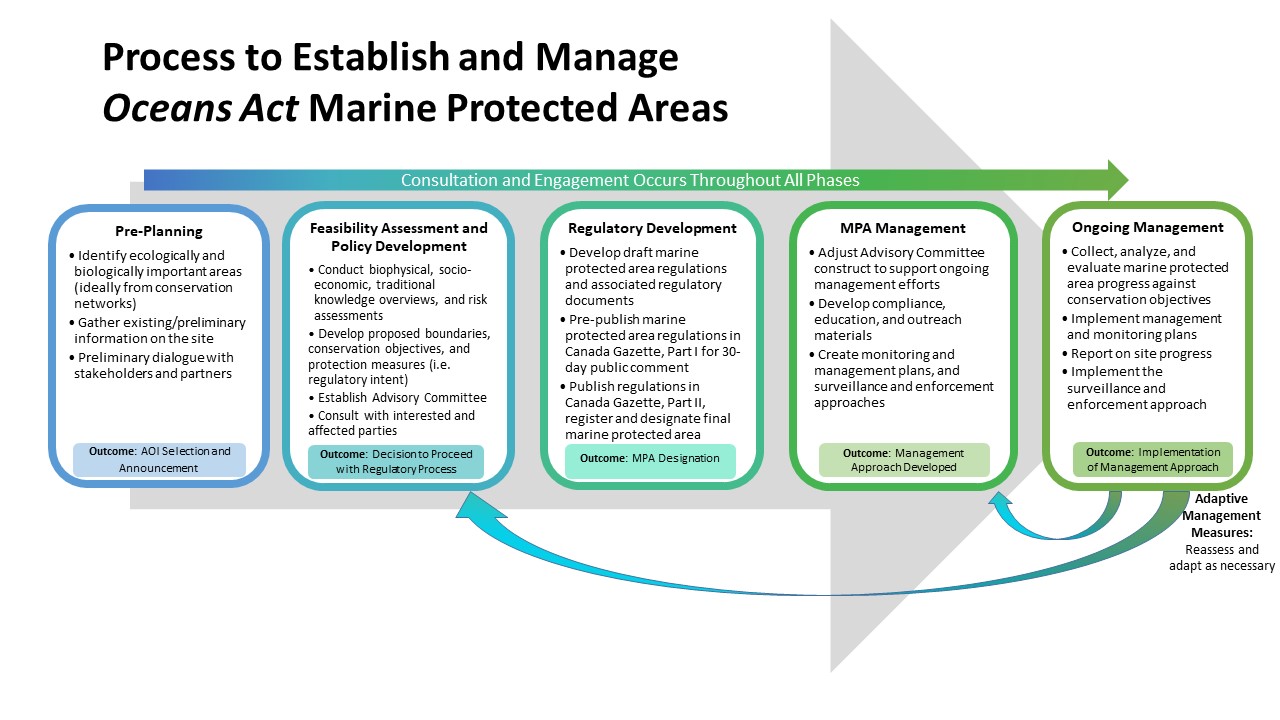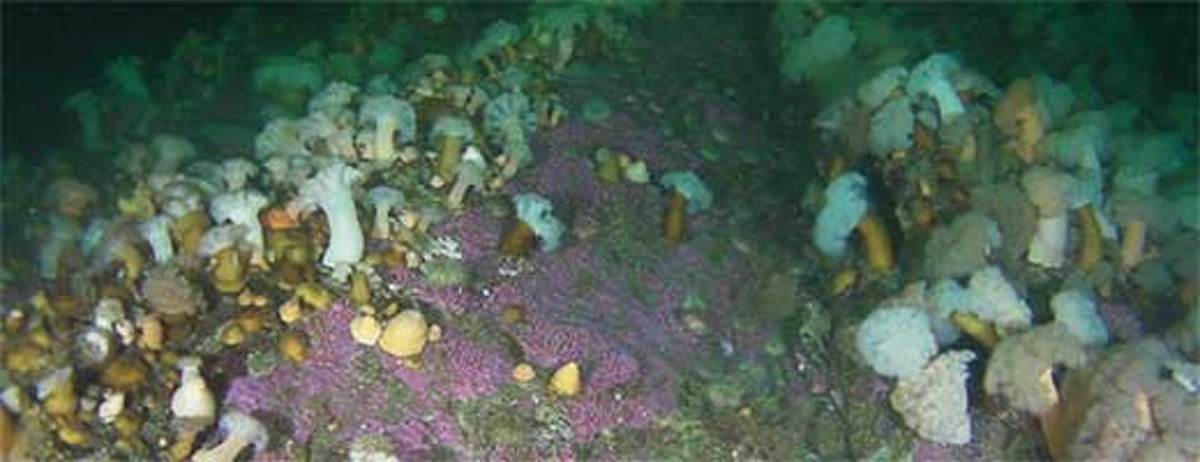Establishing new Marine Protected Areas
Fisheries and Oceans Canada collaborates and consults with provincial and territorial governments, Inuit and Indigenous governments and communities, industry and other maritime economy, stakeholders, environmental groups, and other interested Canadians to identify areas in our ocean and along our coasts that contain important habitats, species, and ecosystems that need protection. When an area needs protection, a Marine Protected Area (MPA) can be established by regulations under the Oceans Act.
Marine Protected Areas by ministerial order
In situations where initial science and consultation points to a need to protect an area, a regulatory tool under the Oceans Act called a ministerial order may be used. A ministerial order establishes an MPA for up to five years. This tool enables the minister of Fisheries and Oceans, and the Canadian Coast Guard to ‘freeze the footprint’ in the area, allowing for existing human activities to occur over the 5 years, while prohibiting new activities from taking place. During this period, additional analysis and consultations take place to determine the long-term conservation approach and inform the development of a site’s protection, including the determination of whether the site will be designated under Governor-in-Council regulations or using other measures. A marine area is identified as a study area when it is under consideration for a ministerial order under the Oceans Act.
Marine Protected Areas by Governor-in-Council regulations
Governor-in-Council Oceans Act MPAs are established by regulations that have been recommended by the minister of Fisheries and Oceans, and the Canadian Coast Guard, and approved by the Governor-in-Council. An MPA’s design and regulations are based on the best available science and a comprehensive understanding of the state of the ecosystem in the area, socioeconomic considerations, traditional and local knowledge, risk assessments, and consultations with partners and stakeholders. A marine area is identified as an Area of Interest (AOI) when it is under consideration for long-term protection under the Oceans Act. An MPA may be established by Governor-in-Council regulations following the end of an MPA being established by ministerial order.
Establishment process
Establishment process
A series of 5 steps are undertaken to establish and manage an MPA by Governor-in-Council regulations. During each stage of the process, consultation and engagement occurs.

Description
Process to establish and manage Oceans Act Marine Protected Areas
Consultation and engagement occurs throughout all phases
Pre-planning
- Identify ecologically and biologically important areas (ideally from conservation networks)
- Gather existing/preliminary information on the site
- Preliminary dialogue with stakeholders and partners
- Outcome: AOI selection and announcement
Feasibility assessment and policy development
- Conduct biophysical, socio-economic, traditional knowledge overviews, and risk assessments
- Develop proposed boundaries, conservation objectives, and protection measures (i.e. regulatory intent)
- Establish advisory committee
- Consult with interested and affected parties
- Outcome: Decision to proceed with regulatory process
Regulatory development
- Develop draft marine protected area regulations and associated regulatory documents
- Pre-publish marine protected area regulations in Canada Gazette, Part I for 30-day public comment
- Publish regulations in Canada Gazette, Part II, register and designate final marine protected area
- Outcome: MPA designation
MPA management
- Adjust advisory committee construct to support ongoing management efforts
- Develop compliance, education, and outreach materials
- Create monitoring and management plans, and surveillance and enforcement approaches
- Outcome: Management approach developed
Ongoing management
- Collect, analyze, and evaluate marine protected area progress against conservation objectives
- Implement management and monitoring plans
- Report on site progress
- Implement the surveillance and enforcement approach
- Outcome: Implementation of management approach
Adaptive management measures: Reassess and adapt as necessary
Step 1: Pre-planning
- Preliminary dialogue with stakeholders and partners is undertaken
- Ecologically-important areas are identified and existing information and data on the site is gathered
- AOI is selected and announced
Step 2: Feasibility assessment and policy development
- An AOI advisory committee is established to provide a venue for interested and affected parties to offer input into the establishment of the MPA
- The AOI boundary (including zoning, if applicable), conservation objectives, and conservation measures are finalized with consultation occurring with any interested and affected parties.
- Overviews and assessments (ecological and biophysical, social, cultural, economic, risks posed by human activities) are completed for the AOI and conservation measures are proposed.
- The selection of allowed human activities and the conditions under which they can be carried out are determined based on the level of risk associated with the activities to the achievement of the MPA conservation objectives. In addition, bottom trawling, mining, dumping and oil and gas activities are prohibited in all new federal MPAs, under the MPA Protection Standard.
Step 3: Regulatory development
- Key regulatory documents (regulations, regulatory impact analysis statement) are developed.
- Canadians are provided the opportunity to comment on the proposed MPA during a public comment period following the pre-publication of the proposed MPA regulations in Canada Gazette, Part I.
- The MPA is designated and the final MPA regulations are published in Canada Gazette, Part II.
Step 4: MPA management
An MPA management framework tailors MPA management towards achievement of stated MPA goals and objectives, resulting in more effective and efficient protection. This may yield greater ecological benefits and associated ecosystem goods and services. The key elements of an MPA management framework are the conservation objectives, the MPA management plan; the MPA monitoring plan (which includes monitoring indicators, protocols and strategies); compliance and enforcement; and public education and outreach.
- The MPA management plan provides guidance to affected and interested parties on the MPA regulations and associated management measures, as well as on non-regulatory measures (e.g., best management practices, public awareness through communications) to achieve the MPA objectives. MPA management plans are drafted with partners (where applicable) and with input from stakeholders. Management is guided by management boards (where collaborative arrangements are in place) and supported by an advisory committee.
Step 5: Ongoing management
The MPA regulations follow a lifecycle approach, meaning that attention is given both to regulatory development and the implementation, monitoring, evaluation and review of regulations. The lifecycle approach improves the effectiveness, efficiency, and accountability of the regulatory system. The ongoing management of an MPA relies on the collaboration and participation with partners and stakeholders.
Effective MPA management is supported by ongoing monitoring, surveillance and enforcement so that managers can make informed decisions on how to adaptively manage the MPA. The ongoing collection and analysis of information related to an MPA informs evaluation of site progress and provides a basis for adaptive management measures to be applied. An MPA can be adapted via amendments to the management framework or to the regulations, as required.
Establishment process of ministerial order MPAs
While the process to establish an MPA by ministerial order is mostly similar to establish an MPA through Governor-in-Council, there are some differences.
A ministerial order MPA ‘freezes the footprint’ of human activities in the area, allowing those already occurring for a maximum of one year prior to designation to continue for a maximum of five years. Following MPA establishment by ministerial order, analysis conducted to inform the feasibility assessment and policy development would be less extensive than under phase 2 for establishing an MPA under Governor-in-Council regulation. Biophysical, socioeconomic, and resource assessments, as well as Inuit and Indigenous knowledge studies continue and support the determination of the long-term conservation approach for the site. When this approach includes MPA establishment by Governor-in-Council regulation, the regulatory development step is undertaken.
Potential area across Canada
Potential area across Canada

| Site name | Approximate size in km2 |
|---|---|
| Southampton Island Area of Interest | 93,087 |

| Site name | Approximate size in km2 |
|---|---|
| Eastern Shore Islands Area of Interest | 2,000 |
| Fundian Channel-Browns Bank Area of Interest | 7,200 |
| Northern Gulf of St. Lawrence study areaFootnote 1 | 7,089 |
| Shediac Valley Area of Interest | 1,530 |
| St. Lawrence Estuary Area of InterestFootnote 1 | 6,000 |

| Site name | Approximate size in km2 |
|---|---|
| Tang.ɢwan – ḥačxwiqak – Tsig̱is Area of Interest (TḥT AOI) | 133,019 |
| Race Rocks Area of Interest | 2 |
- Date modified:
